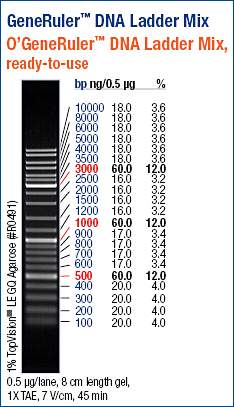The gDNA I extracted on 20151104 didn’t look great on the NanoDrop so I decided to perform a phenol-chloroform cleanup to see if I could improve the NanoDrop1000 absorbance spectrum and, in turn, the quality of the gDNA.
- Added an equal volume (500μL) of phenol:chloroform:isoamyl alcohol (25:24:1) to the DNA
- Mixed by hand – moderate shaking
- Centrifuged 2mins, 10,000g, RT
- Transferred aqueous phase to clean tube and discarded interphase & organic phase
- Added an equal volume (380μL) of chlforoform:isoamyl alcohol (24:1)
- Mixed by hand – moderate shaking
- Centrifuged 2mins, 10,000g, RT
- Transferred aqueous phase (320μL) to clean tube
- Added 0.1vols (32μL) of 3M sodium acetate (pH = 5.2)
- Added 2vols (640μL) of 100% EtOH
- Mixed by inversion
- Incubated @ -20C, 1hr (probably not necessary since gDNA clearly precipitated out as soon as I mixed the sample)
- Pelleted DNA by centrifuging 15mins, 12,000g, RT
- Discarded supe
- Washed pellet with 1000μL cold (-20C) 70% EtOH
- Centrifuged 5mins, 12,000g, RT
- Discarded supe
- Repeated was steps three more times
- Resuspended pellet in 100μL of Buffer EB (Qiagen)
DNA was quantified using two methods: NanoDrop1000 & QuantIT dsDNA BR Kit
For the Quant-IT kit, the samples were quantified using the QuantIT dsDNA BR Kit (Invitrogen) according to the manufacturer’s protocol.
Standards were run in triplicate, samples were run in duplicate.
96-well black (opaque) plate was used.
Fluorescence was measured on the Seeb Lab’s Victor 1420 plate reader (Perkin Elmer).
Results:
| METHOD | CONCENTRATION (ng/μL) | VOLUME (μL) | YIELD (ng) |
| NanoDrop1000 | 547.15 | 200 | 109,430 |
| Quant-IT | 74.26 | 200 | 14,851 |
The NanoDrop1000 overestimates the concentration of the sample by 7.4x! That’s really insane!
Regardless, this is a solid yield (using yield from Quant-IT) and, when combined with the other Ostrea lurida gDNA that I isolated today, should push the total amount of gDNA submitted to BGI over the required threshold.
Will evaluate gDNA quality on a gel.
Fluorescence (Google Sheet): 20151124_geoduck_oly_gDNA_quants
NanoDrop1000 Measurements and Plots
The clean up seems to have worked well, as the absorbance spectrum is much improved and nearly mirrors that of the Oly gDNA isolated with the Mollusc Kit.






